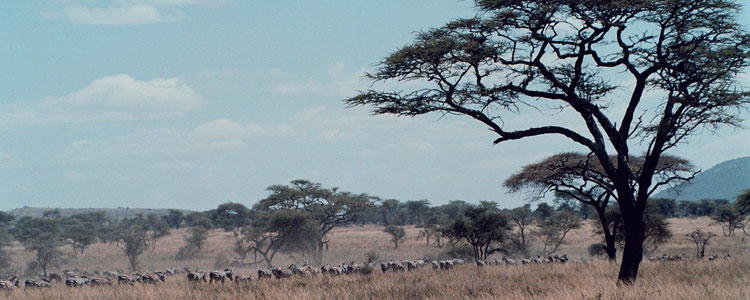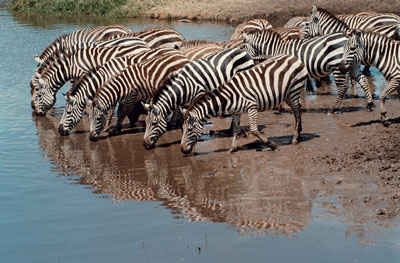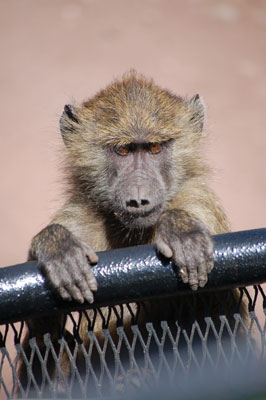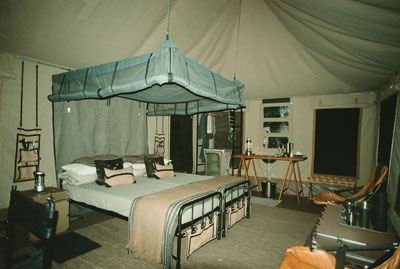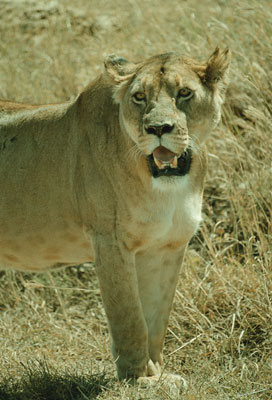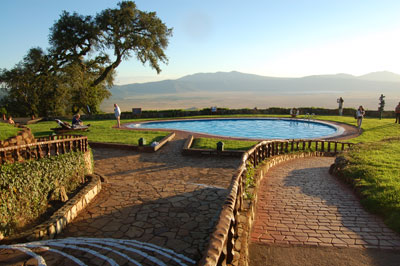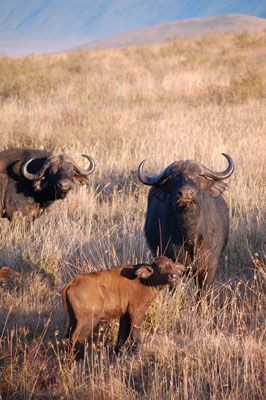Looking for wildlife while living in comfort on a tour of Tanzania
by David Tykol; Editor, ITN
“Wow! This is amazing,” our guide and driver, Saitoti Ole Kuwai, said.
In a small, grassy valley in northeastern Tanzania, I was one of four journalists sitting in a safari vehicle surrounded by hundreds of wildebeests.
Saitoti continued: “The sound! Usually, they are quiet.”
He explained that it was the beginning of the rutting season and that after two months they all would be silent again.
A few minutes earlier we had driven over a hill and were heading down a dirt road. Flat-topped acacia trees and puffy white clouds framed the distant plain and mountains, so I asked Saitoti to stop so I could take a picture.
He cut the engine, and as my camera clicked we became aware of what seemed like the croaking of countless bullfrogs echoing off the hillsides of the tree-filled hollow below. It was the agitated grunting of male wildebeests, but with none of them in sight it was eerie and exciting.
Moving farther down the hill, we found our path blocked by a stream of wildebeests (gnus). As we inched forward, they either continued across the road or bolted a few dozen feet away, eyeing us suspiciously.
More kept coming, all heading in the same direction. They were part of the front flank of the annual migration of more than a million wildebeests and hundreds of thousands of zebras and gazelles in Eastern Africa. At the time of our visit, they were streaming northwest through the Serengeti. They would proceed clockwise just over the border of southern Kenya before trudging back down into Tanzania again months later.
Here and there, two bulls faced each other, heads down, pawing the ground. They would lunge forward and butt heads and shoulders or, more often, pull back at the last second and casually eat grass — in reality each remaining focused on his opponent.
Theoretically, the victor would win a herd of females, some with calves, but during our visit most of the females were missing, the bulk of the group still on its way.
This was the Africa I had hoped to see.
Animals in a bowl
I had been invited by the Tanzania Tourist Board, South African Airways and The Africa Adventure Company to spend about a week, May 31-June 7, 2011, traveling around Tanzania, a republic with one of the continent’s most stable governments. (In September 2011, the country celebrated the 50th anniversary of its independence from Britain.) Our itinerary included stops in Dar es Salaam, Arusha, Ngorongoro Crater and the Serengeti plains.
Most fun, for me, was riding around the game reserves in a four-wheel-drive vehicle — either open-sided or with a pop-up top — trying to spot a leopard, mongoose or rhino before our guide/driver did.
We had two days at Ngorongoro Crater, a special place for wildlife viewing because it has tens of thousands of animals virtually contained within the crater and very well protected.
The result of volcanic activity three million years ago, the crater measures from eight to 12 miles from lip to lip. On its floor is some swampland and, at one end, even a small “forest” of spindly trees, but we spent most of our time in its central plains, which were pan-flat and, during our visit, covered in dry grasses.
The crater’s interior was quite a contrast to its exterior, where, on our zigzag drive up, we passed a strip of some of the most densely packed green jungle I’d ever seen.
Within the Ngorongoro Conservation Area, all vehicles must stay on the roads. Still, chances of seeing all the different types of big mammals present are good. Over two days of driving the dusty, crisscrossing roads, we saw four of the Big Five.
Our guide at Ngorongoro, Ephata Lotashu (a guide for The Africa Adventure Company and a true professional), said there might be 70 to 100 lions in the crater. Among notable species missing there are giraffes and impalas.
Ngorongoro Sopa Lodge
Our hosts wanted to show us some of the best that Tanzania has to offer, and that included showcase lodges (Serena Mountain Village, Gibb’s Farm, Singita Faru Faru Lodge, etc.) and safari camps (such as Singita Sabora Tented Camp).
We had a meal or tea at so many incredible properties in isolated locations with spectacular views, and at each I just wanted to stake out a lounge chair and order a drink.
Four lodges are situated on the rim of Ngorongoro Crater, and we spent a night at the largest, the 186-guest Ngorongoro Sopa Lodge. Its lobby draws you straight through to the outdoor swimming pool overlooking the crater floor a couple thousand feet below.
Its dining hall resembles a round, thatch-roofed hut but is massive, with tall, floor-to-ceiling windows on the view side. I was impressed with the room’s acoustics; even with its tables full of chattering people, everyone in our group could hear each other clearly while talking in normal tones of voice.
My very spacious suite included a curtained-off alcove with cane rocking chairs and picture windows. I appreciated the fact that, as at several lodges, the room had no TV. There also was no phone, though one could be delivered upon request.
It all seemed great until I realized that none of the windows opened and the suite was, essentially, hermetically sealed. It was like watching Africa on TV. I couldn’t even hear the birds in the morning.
At night, even with the room’s lights off, there was glare on the picture windows. I could see out only by pressing my nose against the glass and cupping my hand over my eyes. (Three in our group shared this problem, but one said she could see the stars from her bed plus any wildlife that might wander by.)
This lodge was very well run, with a friendly staff. On the evening we were there, traditional Maasai dances were performed in the lobby.
Situated on the eastern rim, the Sopa has advantages over the three other lodges on the edge of the crater, including a private, shorter access road to the crater floor and great views of the sunsets.
The Manor at Ngorongoro
My favorite accommodation of the trip, one just outside the conservation area, was The Manor at Ngorongoro, an eye-pleasing, Cape Dutch-style manor with complementary duplex cottages, all surrounded by trees, tended green lawn and flowering plants.
My cottage suite, one of 18, had a wooden deck and lounge chairs facing the neat rows of a coffee plantation, with mountains visible in the distance.
An old-fashioned skeleton key opened the front door, leading to a split-level suite — living room below and bedroom three steps up — that felt both spacious and cozy at the same time. In the center was a fireplace open to both sides. The bathroom included a shower and a claw-footed tub.
Not far from the horse-riding stables was the manor, itself, with dining rooms, a library and a lounge/bar full of plush couches.
Aside from the personable couple managing the manor, what sold me on this place was the breakfast room. This bright space dotted with plants had a glass-paneled ceiling plus lots of arched windows looking out to the garden and valley. From the menu, I chose a dish of honey-glazed ham, spinach, poached eggs and cheddar cheese sauce and it was fantastic.
At the Manor, meals are served not at set times but when each guest wants them.
Even though this property did not say “Africa” to me (except I did see a dwarf mongoose, looking like a short-legged brown house cat, outside my cottage), I loved it. Very homey!
Serengeti and Grumeti
Our group also had a couple of days in Serengeti National Park and, to its northwest, the smaller, private Singita Grumeti Reserves. In Grumeti, vehicles are allowed to leave the road, making for better photo ops.
No matter where we were in Tanzania, if we drove for 15 minutes or so the terrain would be different somehow. In the wildlife areas, we spent most of our time on grassy plains with scattered trees, mostly varieties of acacias, but we also drove through hills with a few fat-trunked baobab trees and past rock ledges and Lake Manyara.
One afternoon in Grumeti, within an hour we went from watching an orange-tinted, spotted leopard that was napping on the branch of a sausage tree, legs and tail dangling, to photographing a tawny, spotted cheetah snoozing and yawning under an acacia.
The big cats we saw never showed any reaction to people talking or laughing. Saitoti, who is a guide for guests of Singita Game Reserves properties and who shared insights about animals and the environment at every opportunity, told us to just not stand up or wave our arms around in such a way as to “break up the unit of the vehicle.”
“The vehicle poses no threat and is not food,” he said.
One time, in the Serengeti, ours was one of 12 vehicles beside a tree with a leopard, but that was unusual. Really, we seldom encountered another vehicle in any of the wildlife areas.
Singita Explore tented camp
In the Grumeti Reserves, we “roughed it” at the Singita Explore mobile tented camp. I was blown away that my tent had almost every amenity of a nice hotel room.
Measuring 258 square feet, my quarters, one of six two-person tents, contained a luggage rack, chest of drawers, writing desk, end tables, chairs, battery-powered lanterns, stainless-steel sink and faucet, bath towels, a queen-sized bed draped with mosquito netting and, connected just outside one corner, a 32-square-foot tent with a shower and a stainless-steel flush toilet.
We each scheduled a shower time, just before which staff would fill the overhead tank with hot water.
On all sides of each tent, flaps could be rolled up, leaving fabric screens through which breezes could blow and the plains and mountain ridge could be seen while still keeping any bugs out.
For our dinner that night, the cook prepared whole chickens by placing each over an open can of beer and roasting them in a covered barbecue. She said the beer (or sometimes cola) kept the chicken moist and tender. She was right.
Salad and a special Indian curry squash dish were equally delicious, followed by apple pie “crumble.” She even made a fresh batch of peanut butter cookies.
As at all of the safari lodges and camps at which we stayed, guests were not allowed to walk outside without an escort from dusk to dawn. Also, in Grumeti, any walking safari must be led by an armed wildlife officer, so advance notice is required.
Not far away, we could hear the complaining of wildebeests. They had “arrived” just a couple of days before we did. They choose a different migration path each year, so it’s a guess as to where to place the mobile camp to get it near their path.
The Singita Explore camp is reserved for the exclusive use of any group, whether it comprises two adults (the minimum) or 12; unused tents are left unoccupied.
Sasakwa Lodge
Presenting a different perspective of the Serengeti, the sumptuous Sasakwa Lodge, East Africa’s only Relais & Châteaux property, houses up to 34 guests in cottage suites.
I ended up in “Hemingway’s Cottage.” With wood trim, chandelier, fireplace and zebra-skin ottoman, its lounge made me want a cigar (and I don’t smoke).
As did other units at Sasakwa, my suite had a private patio with a small, heated infinity pool plus a mounted telescope for viewing wildlife on the plain below.
Arusha
In our travels in the northeast, the main roads we took were smoothly paved. We passed through Arusha, not far from Lake Manyara, several times, during both day and night. With a few trees blossoming in orange or purple plus green growth everywhere, the city seemed like an oasis, and I was fascinated with all the activity along the roadside.
In front of the mostly one- and two-story businesses and cinderblock or brick homes, people sat in the shade selling everything from shoes to fresh-roasted corn on the cob.
By the way, at all the places at which we stopped to eat on this trip, our meals featured fresh fruit, including, at the least, watermelon, cantaloupe, papaya, strawberries and orange slices.
Outside of cities and game reserves, the most common sight along the road, in or out of towns, was herds of goats, each with a shepherd or two. There also were some cows and a number of donkeys. Among the Maasai, the more cows a man owns, the more wives he can afford.
Not 20 minutes out of Arusha in one direction, the terrain very quickly became dry and brown. This was Maasai country, and we saw tribe members wearing lots of jewelry and wrapped in traditional cloth, either blue or red, depending on their tribe.
In Karatu, a town near Gibb’s Farm, the Wednesday Maasai market was packed with people selling clothing, housewares, vegetables, etc. — all the everyday necessities.
We were in Tanzania after the rainy season, so mosquitoes were scarce. It had last rained in Ngorongoro Crater three weeks previously and in the Serengeti five weeks before, at the beginning of May.
Nevertheless, I used DEET-soaked towelettes a couple of times a day and, provided in the mobile camp, a less-messy roll-on product that had no DEET. Still, I did get bitten a few times, both in the Serengeti and in the higher-altitude Ngorongoro area.
One member of our group said she got about 20 bites but that none were from mosquitoes. Most likely they were from tsetse flies. Only one member of our group got no bites at all. She was wearing ExOfficio repellent-treated clothing.
South African Airways
Before this trip, I had been dreading the transatlantic flights between New York and Johannesburg, 14½ hours heading over and 16 hours coming back, but, sitting in business class on an Airbus 340-600 of South African Airways (800/722-9675), I found these the most enjoyable flights I’ve ever taken.
Simple control panels showed me how to bend my roomy chair into the most comfortable position, including completely flat. With that and a big blanket, I got seven hours of uninterrupted sleep — something I’ve never experienced on a plane before.
In addition to an adjustable book light, we each had our own entertainment console plus headphones. At meals, I liked the selection of fresh breads, and my three pieces from a rack of lamb filled me up.
So I was a little disappointed to find that when flying the 3¼ hours between Johannesburg and Dar es Salaam, again in SAA’s business class but this time on a Boeing 737-800, my seat tilted back only a couple of inches, with not even a foot rest. Also, at the angle it was facing, all I could see on the digital TV screen by the ceiling were ghost-like images, and the same TV show episodes were played in both directions.
The best part of the Jo’burg/Dar legs were the flight attendants, who each smiled genuinely and had a good sense of humor.
Between Dar es Salaam and Arusha we flew for an hour or so with Precision Air. On the ATR prop-jets, there was a palm-sized, ceiling-mounted TV screen for each couple of seats.
Between Arusha and parts of the Serengeti we flew in de Havilland Twin Otter prop planes, never going above 6,000 feet and during one 15-minute leg flying at only a couple thousand feet (great views).
Heading home, on the flights of both Precision Air and SAA, the cabin was summarily sprayed with insecticide. “If you wear contact lenses, close your eyes,” it was announced each time.
Your safari
Tanzania is not known as a “self-drive” destination; visitors each select or customize a package from a tour operator. The Africa Adventure Company (Ft. Lauderdale, FL; 800/882-9453), which I can recommend, offers packages in Tanzania as well as in many parts of Africa and Madagascar.
In Tanzania, most of their patrons arrange private, tailor-made safaris, usually variations on any of the dozens of “mid- to upper-price” packages available. Scheduled tours range from 10 days ($2,250-$3,450 per person, double occupancy) to 17 days ($5,595-$6,095 each).
I had the company price a customized trip for two people staying where I stayed. If you include a night at Serena Mountain Village at the beginning and end, a seven-night/nine-day itinerary with one night at The Manor, a night at each of the two lodges and two nights (the minimum) at the tented camp would cost $5,495 per person, low season, to $7,250, high season, including two in-country charter flights plus a private driver/guide on days three to seven.
The above package prices include accommodations (and taxes), all meals, domestic flights (where stated), airport/lodge transfers, game drives, park fees, driver/guides and flying doctor service. Some safari camps and lodges include “local” drinks and laundry service. Not included are international airfare, Tanzania visa, airport departure taxes, travel insurance and tips to guides and drivers.
Regarding tipping, your safari guide should get $30 to $40 per day from the whole group, with up to $10 per person going to a driver for transfers taking up to an hour. Additional tips include $5 per person per day to the staff pool at any safari camp (at large lodges, such a tip is not expected), $1-$2 per person per day to a room maid and $1 to a waiter bringing you a drink. Tips to porters and waiters (normally $1-$2 per person) will be handled by your guide.
While I have high praise for our guides Saitoti and Ephata, it cannot be guaranteed that specific guides will be available. Each has personal obligations.
Trust your guide
During our two days at Ngorongoro Crater, we rode around in an “extended” Toyota Land Cruiser. At one point, Ephata drove the five of us to a large, reed-ringed pond, parking near two cinderblock restrooms, the only manmade structures we had seen for hours. A couple of other Land Cruisers were already there.
We made use of the facilities, then wandered down to the pond. I could see, on the far side, the shiny, boulder-like backs of a few hippos.
Our break over, we hopped back in the cruiser and Ephata started taking us up the road but suddenly stopped. Sauntering toward us was a lioness, mouth slightly open. She continued slowly past us and down toward the rest area.
A moment later she stopped, pricked up her ears and looked in the direction of one of the vehicles below, where travelers were standing around laughing.
“Shouldn’t you radio them?” one of our group asked. Ephata just studied the lioness and said, “She’s heading toward the zebras.” There was a small herd about a quarter mile away.
After a minute the lioness proceeded casually toward the people, one of whom, finally, pointed at her, now 40 yards away. All scurried into their cruiser, one man pulling a woman by the hand.
Ephata drove us slowly after the lioness as she walked past the restrooms we had just used and toward a patch of grass where another group was having a picnic. It was a kick to watch as they, too, saw the lioness and began making decisions about which dishes and ice chests to put back in their vehicle before climbing in, themselves.
But she just kept walking in the direction of the zebras. We drove away to see what else we could find.
Ephata said that no one has ever been attacked by a lion in the crater: “They’re more interested in four-legged prey.”
Always a show
What I wished for from my trip to Tanzania was to see lots of wildlife up close, and I sure did, racking up jackals, elands, elephants, rhinos and baboons plus irridescent and gargantuan birds as well as butterflies, hissing ants and on and on. What I didn’t expect was the high level of luxury available at many lodges and safari camps.
Saitoti told us that as the masses of wildebeests and zebras pass through an area — with random panic stampedes and, in certain months, bulls fighting — many animals of other species go elsewhere to avoid the commotion and constant false alarms. So if your Tanzanian safari doesn’t coincide with the migration, it’s likely you’ll see more giraffes, buffaloes, topis, elands and elephants.
To learn more, contact the Tanzania Tourist Board (347 Fifth Ave., Ste. 1205, New York, NY, 10016; 212/447-0027).

